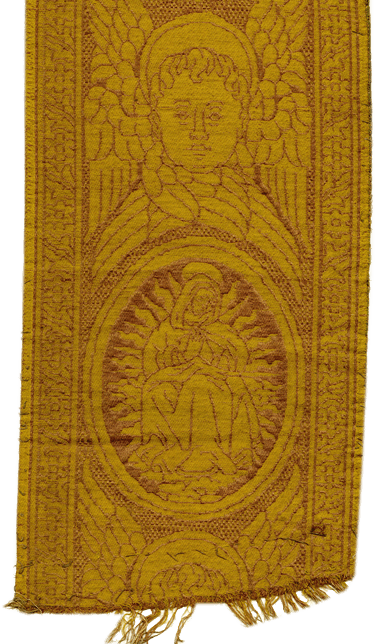


Orphrey with Virgin and Child, Seraphim, and ‘IHS’ Monogram
, Italy, Florence, c. 1500




Orphrey with Virgin and Child, Seraphim, and ‘IHS’ Monogram
Description
Woven orphrey panel in gold and red silk pink/ apricot depicting the Virgin, winged Seraphim, and the IHS Christogram. The motif of the six-winged seraphim head, the IHS – Christogram, within a glory of rays, and the Virgin were common motifs. Such a band would have been sewn onto a chasuble.
One of five medieval/ Renaissance weaving techniques, lampas is created on a loom with a ground weave with supplementary wefts (pattern wefts) laid on top and forming a design, sometimes with a “brocading weft.” Most lampas are woven of silk with either gold or silver thread enrichment. The technique allows for the creation of complex designs, including floral and geometric patterns, as well as figural elements (here, the Seraphim and the Virgin).
Similar examples are preserved at the Metropolitan Museum in New York (inv. 11.61.4), the Bargello in Florence (inv. 371.M), the Kunstgewerbe Museum in Dresden, and the Musée des arts décoratifs in Paris.
Provenance:
Private Collection, France (Normandy), formed in 1900, sold Paris, Etude Couteau-Bégarie, 2008, lot 406.
Literature:
Marco Ciatti, Drappi, Velluti, Taffeta et alter cose, Siena, 1994, p. 70 ff.; Monique King and Donald King, European Textiles in the Keir Collection, 400 BC to 1800 AD, London and Boston, 1990, Ch. 6, Renaissance Woven Pictures, 1450-1550, (nos. 75-86), pp. 112-125, no. 85, Orphrey with Virgin, Seraphim and (IHS) Christogram in yellow on pink (lampas, with satin ground and compound twill), early 16th century; Jose Luiz Santoro, Tessuti Figurative a Firenze Nel Quattrocento, Antichita Piselli, Firenze, 1981, pp.22-41, catalogue entries, 6-12, and 9 and 11 for comparable examples for horizontal and vertical orphrey panels.